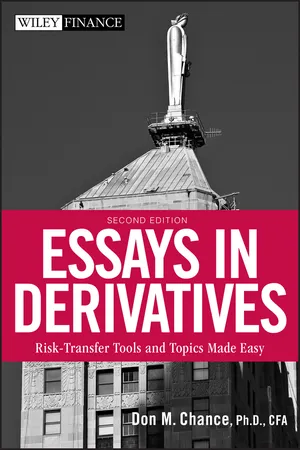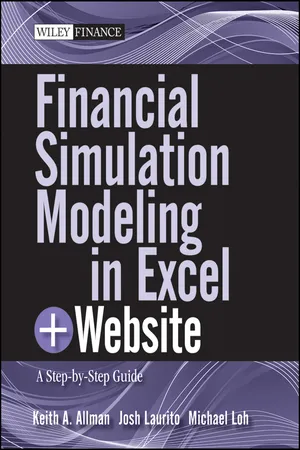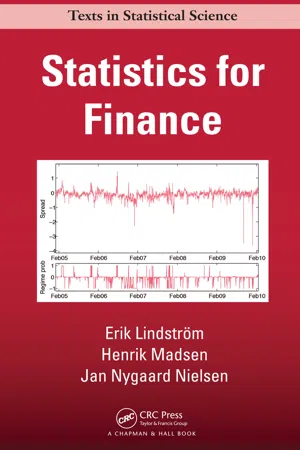Business
Binomial Model
The binomial model is a mathematical tool used to evaluate the value of options. It assumes that the price of the underlying asset can move up or down over time in a series of steps. By calculating the expected value at each step, the model helps businesses make decisions about options and other financial instruments.
Written by Perlego with AI-assistance
Related key terms
6 Key excerpts on "Binomial Model"
- eBook - ePub
Essays in Derivatives
Risk-Transfer Tools and Topics Made Easy
- Don M. Chance(Author)
- 2011(Publication Date)
- Wiley(Publisher)
Thus, one advantage of the Binomial Model is that it does not require knowledge of continuous-time models, Brownian motion, stochastic differential equations, and the like. In fact, the basic Binomial Model requires no calculus at all. Yet it captures all of the essential principles involved in option pricing. Consequently, the Binomial Model has pedagogical value in learning option pricing. For example, the Binomial Model shows us that the price of an option can be stated as a discounted expected value of the option at expiration. The probabilities involved in computing the option’s expected value are those that would exist if investors are risk neutral, meaning that they do not perceive any advantage or disadvantage to risk. This point sounds a bit paradoxical, and we shall take it up in a later essay. The BSM model leads to the same conclusion, but in the BSM model, the point is more obscure.There is yet another major advantage of the Binomial Model. We hardly need it to verify the BSM price, but often we are interested in options that are not standard European. American options, for example, are sometimes exercised early and therefore should sell for higher prices than their European counterparts. The Binomial Model enables us to check at the various points in an option’s life for the possibility of early exercise. If early exercise makes sense at any point in time, we assume the option holder would do so. Then the otherwise computed values of the option are replaced by the exercise values. Only one additional line of code is required in most programs. Other more complex options of the type often seen in over-the-counter markets today can also be priced by using the Binomial Model or a variation thereof, but the code does become quite detailed and the procedure slows down considerably. In many cases the trees become quite bushy.The binomial framework is also useful in modeling movements in the term structure of interest rates, which allows us to obtain arbitrage-free prices of bonds and derivatives on bonds and interest rates. We shall cover this topic in Essays 60 to 64. - eBook - ePub
- Paul Wilmott(Author)
- 2013(Publication Date)
- Wiley(Publisher)
CHAPTER 15
the Binomial Model
In this Chapter…
- a simple model for an asset price random walk
- delta hedging
- no arbitrage
- the basics of the binomial method for valuing options
- risk neutrality
15.1 INTRODUCTION
We have seen in Chapter 3 a model for equities and other assets that is based on the mathematical theory of stochastic calculus. There is another, equally popular, approach that leads to the same partial differential equation, the Black–Scholes equation, in a way that some people find more ‘accessible,’ which can be made equally ‘rigorous.’ This approach, via the Binomial Model for equities, is the subject of this chapter.Undoubtedly, one of the reasons for the popularity of this model is that it can be implemented without any higher mathematics (such as differential calculus) and there is actually no need to derive a partial differential equation before this implementation. This is a positive point, however the downside is that it is harder to attain greater levels of sophistication or numerical analysis in this setting.Before I describe this model I want to stress that the Binomial Model may be thought of as being either a genuine model for the behavior of equities, or, alternatively, as a numerical method for the solution of the Black–Scholes equation.1 Most importantly, we see the ideas of delta hedging, risk elimination and risk-neutral valuation occurring in another setting.The Binomial Model is very important because it shows how to get away from a reliance on closed-form solutions. Indeed, it is extremely important to have a way of valuing options that only relies on a simple model and fast, accurate numerical methods. Often in real life, a contract may contain features that make analytic solution very hard or impossible. Some of these features may be just a minor modification to some other, easily-priced, contract but even minor changes to a contract can have important effects on the value and especially on the method of solution. The classic example is the American put. Early exercise may seem to be a small change to a contract but the difference between the values of a European and an American put can be large and certainly there is no simple closed-form solution for the American option and its value must be found numerically. - eBook - ePub
Sustainability in Business
A Financial Economics Analysis
- David Hobson Myers(Author)
- 2020(Publication Date)
- Palgrave Macmillan(Publisher)
4 .Returning to concepts of utility and value, when a hard line is drawn or strict definition adhered to the economic implications may seem absurd. The implication is that of an infinite cost to adherence. In the moment, decisions of absolutes may seem reasonable. In particular, the current political environment of populism is basically “my group before all others” or in social distance terms, zero social distance for my group, and an infinite social distance for anyone else.Later in Chapter 6 within the discussion of risk, return, and sustainability trade-offs, it will become evident that how a business or investor handles such trade-offs will have a definite impact on the business and marketing of that business.Binomial Pricing Models for Uncertainty
Another model common in financial and investment valuation is the binomial pricing model. Employing Binomial Models for sustainable decision making has many benefits for managers dealing with uncertainty. Binomial pricing models combine expected returns and their probabilities with discounted cash flows to model the dynamics of an uncertain future.The mathematics of binomial pricing is straightforward. The probabilities of the two outcomes are the probability of one outcome, p, and one minus that probability of the other outcome, 1−p since the probabilities must sum to 100% or 1. The expected value is the probabilities times the value in that outcome state. In the equation below, p is the probability of the good or up (u for up) state and V u is the value in the upstate. The downstate (D for down) probability is (1−p ) and its value is V D . If those outcomes are in the future, then the addition of a discount rate, 1/(1 + r ), brings the expected value from the future to an expected value in the present (Fig. 2.3 ).Fig. 2.3 Binomial pricing - eBook - ePub
Derivative Pricing
A Problem-Based Primer
- Ambrose Lo(Author)
- 2018(Publication Date)
- Chapman and Hall/CRC(Publisher)
4 Binomial Option Pricing ModelsChapter overview: This chapter marks the beginning of option pricing, which is the central theme of Part II of this book. Unlike the pricing of prepaid forwards and forwards, option pricing is inherently model-dependent, i.e., different models of the stock price give rise to different option prices. Consider, for instance, the pricing of a K-strike call. Loosely speaking, the price of the call depends on the thickness of the right tail of the stock price distribution beyond the strike price K. The more likely the stock stays above K at expiration, the higher the call price. Similar considerations apply to a put, for which the left tail of the stock price distribution plays a pivotal role.In this book, you will learn two broad classes of option pricing models, namely, the discrete-time binomial option pricing model (Chapter 4 and part of Chapter 8 ) and the continuous-time Black-Scholes model (Chapters 5 to 8 ). The discrete-time Binomial Model is intuitively easy to understand and, albeit simplistic to some extent, gives you the valuable intuition that carries over to the more complicated Black-Scholes model. More importantly, all derivatives can be priced and hedged in this discrete-time framework, at least in theory. The Binomial Model therefore forms the ideal starting point for understanding option pricing.This chapter describes the mechanics of valuing options in the binomial option pricing model. Section 4.1 sets the stage, introducing the one-period Binomial Model and illustrating many of the essential ideas that underlie option pricing in general. In particular, the conceptually and practically important methods of pricing by replication and risk-neutral pricing are presented with brief discussions on their pros and cons. The valuation task is continued in Section 4.2 , where we extend the simple one-period model to multiple periods, and the method of risk-neutral pricing remains to thrive. American options are treated in Section 4.3 , in which we will see that pricing European options and pricing American options share essentially the same fundamental ideas. Options on other underlying assets such as exchange rates and futures are studied in Section 4.4 . Finally, Section 4.5 - eBook - ePub
Financial Simulation Modeling in Excel
A Step-by-Step Guide
- Keith A. Allman, Josh Laurito, Michael Loh(Authors)
- 2011(Publication Date)
- Wiley(Publisher)
CHAPTER 4 Option PricingWith a set of basic skills developed, we can now move on to practical application. The first financial realm that we will apply simulation techniques to is option pricing. As we work our way through option pricing, you will see that simulation techniques can take on many forms and be intertwined with multiple financial disciplines. For instance, in the derivatives or options industry, one routinely encounters discussions about bonds, which then leads to interest rates. One may wonder why, if the purpose of a stock option is to purchase stocks, that one would need to know anything about the bond market? The quick answer to this question is that to price an option, the price must in some way be enforced by a market driven asset that represents the cost of borrowing as viewed by the entire financial industry. That asset is a bond, and it is the anchor all the derivative and option pricing models adhere to. We will discuss this concept in a little more detail further on, but to begin with we will start off with the most basic pricing model, the binomial tree. To demonstrate why an enforcer is necessary, we will use the binomial tree to model our most basic asset, the stock.A note: This text is focused on practical application and will not formally explicate binomial trees. It also assumes that the reader is familiar with options and bonds as financial instruments. Binomial trees will be discussed only in a general sense to present ideas and concepts necessary to understand how to implement the Hull-White Trinomial tree later on. If the reader is interested in learning more about the theory of binomial trees, there are many good texts that cover this topic in more detail.BINOMIAL TREESThe most basic method of presenting stock price movement is a binomial tree. It is very similar to the Brownian motion process we discussed in Chapter 3 except the step size can be of an arbitrary magnitude and the probability of an up or down movement does not necessarily have to be equal. - eBook - ePub
- Erik Lindström, Henrik Madsen, Jan Nygaard Nielsen(Authors)
- 2018(Publication Date)
- Chapman and Hall/CRC(Publisher)
Chapter 3 Discrete time financeThis chapter will describe discrete time models in order to introduce the reader to some of the basic concepts to be used in subsequent chapters on continuous time. The theory in discrete time is simpler as the proofs only require linear algebra.In this chapter we shall consider simple models of security markets and describe the basic principles of valuation of contingent claims (e.g., options, futures). The key idea behind valuation in markets with uncertainty is the notion of absence of arbitrage. Roughly speaking, an arbitrage is a situation where an investor, through buying and selling securities, takes a “position” in the market which has zero net cost and which guarantees 1) no losses in the future and 2) some chance of making a profit. In a model free of arbitrage such investments are not possible.3.1 The binomial one-period model
Consider a financial market with two securities, a stock and a bond, and two time points t = 0 and t = 1. The bond is a riskless asset with initial price B 0 , and price (1 + r )B 0 at time t = 1, where r > 0 is the deterministic constant interest rate and (1 + r )−1 is the discounting factor. The initial stock price is given by S 0 and the price at time t = 1 is assumed to be unknown. At time t = 1 the market can be in either of two states. With probability p the stock price will beS 1 1associated with state 1 (the upper index indicates the state), and with probability 1 − p the stock price isS 1 2at time t = 1.Figure 3.1: The binomial branch for the stock and the bond.Suppose an investor is interested in a contract, e.g., an option which pays c 1 if state 1 is realized and c 2 if state 2 is realized. What should such a contract cost in the one-period financial market consisting of a stock and a bond? One suggestion would be to price the contract as the expected value of future payoffs, discounted by the factor (1 + r )−1 . Let V
Learn about this page
Index pages curate the most relevant extracts from our library of academic textbooks. They’ve been created using an in-house natural language model (NLM), each adding context and meaning to key research topics.





